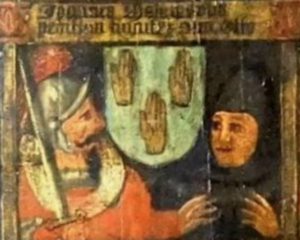Johannes de Malamanus facts for kids
Quick facts for kids
Johannes de Malamanus
|
|
|---|---|

Malamanus in Tabula Eliensis, 1596
|
|
| Born | |
Johannes de Malamanus was a Norman officer. He lived during the time of William the Conqueror, a famous king. Johannes is known for two main things. First, he was one of the knights stationed at Ely. This happened because of a rebellion led by Hereward the Wake. Second, many people believe he was the ancestor of the Milman family.
Contents
The Story of Johannes de Malamanus
Most of what we know about Johannes de Malamanus comes from a writer named Robert Orford. He wrote about the Siege of Ely. This was a long fight where the Normans surrounded the Isle of Ely.
The Rebellion at Ely
In 1071, the Normans finally broke through Hereward's defenses. The rebels had been surrounded for several years. After their defeat, the rebel leaders asked King William I for forgiveness. They went to Warwick and brought many valuable gifts. These gifts were meant to show they were sorry.
King William I agreed to forgive them. But he had a condition. Forty of his royal officers had to stay at Ely. They would be looked after by the monks there. The King was worried about future revolts at Ely. He was busy fighting in Scotland against Malcolm III.
Life as a Norman Officer
Johannes de Malamanus was one of these officers. He was an ensign, which meant he was a leader of foot soldiers. He arrived with other Norman knights and gentlemen. Each officer was assigned a monk to look after them. Johannes was assigned to Otto the Benedictine monk.
A historian named James Bentham wrote about these Normans. He said they were important gentlemen from the best families. They were officers in the King's army. They were sent to Ely to be cared for by the Abbey. This was until the King needed them or could find other places for them.
Friendships and Farewell
The group of officers stayed at the Abbey for five years. They ate with the monks in the Great Hall. By 1078, the officers and monks had become good friends.
Then, King William I sent the officers on a new mission. He needed them to stop his son Robert's rebellion in Normandy. Robert was causing trouble there. Robert Orford wrote that the knights were sad to leave. The monks were also very upset. They cried and shouted in despair. Otto and the other monks even walked with Malamanus and his friends to 'Hadenham.' They walked in a procession, singing hymns.
Johannes de Malamanus's Lasting Impact
We don't know much about Malamanus's life after he went back to Normandy. However, William Miller believed that Johannes was the founder of the Milman family.
Family History and Symbols
This idea is supported by Malamanus's personal Arms. These were painted in Ely's Great Hall by the monks after he left. These Arms match the Arms of the Milman family. The design is "Azure, 3 sinister gauntlets argent." This means a blue shield with three silver left-handed gauntlets (gloves).
Miller also shared a story about the name 'Malamanus.' It means 'bad-hand.' This name might have come from Johannes being left-handed. This seems likely because his Arms show three left hands. By the time Miller wrote about them, the Milman family was well-known. They lived in places like Devon, Holderness, and Chelsea.
A Depiction in Art
Johannes de Malamanus is shown in a painting from 1596. It is called the Tabula Eliensis. He is pictured with Otto the Benedictine. This part of the painting shows the "forty knights and gentlemen who were quartered with the monks of Ely during the reign of William the Conqueror."

